INDIAN COAST GUARD
"Vayam Rakshamah - We Protect"
The Indian Coast Guard is India's youngest and smallest Armed Force. Unlike the BSF or CISF it is not a Police Force but a part of our Armed Services. Unknown to most it is the fourth largest Coast Guard in the world after the US, Japanese & Chinese Coast Guard Arms.
ICG or just CG - Indian Coast Guard; ICGS - Indian Coast Guard Ship, the prefix used with the ships name; OPV - Offshore Patrol Vessel; EEZ - Exclusive economic Zone Why a Coast Guard?
In 1973 international rounds of negotiations commenced under the aegis of the third UNCLOS {United Nations Convention on the Law of the Sea}. Here the philosophy on the table was for each maritime nation to have an Exclusive Economic Zone stretching out to 200 nautical miles from the coastline. This was to be exclusively for the economic exploitation by that country - fishery, seabed minerals and natural resources. Other countries' ships continued to enjoy freedom of navigation through this zone but economic exploitation became exclusive.
India was one of the nations that took an active lead in helping frame these laws and spoke up for protecting the interests of the third world nations most of which had gained independence only recently and all of whom lacked the resources to ward off economic exploitation by the first world. The policy became final in 1982 and was fully adopted only in 1994 after 60 countries in all signed it. Today 168 countries are signatories. Of the major nations with a seaboard only USA, Turkey, Peru and Venezuela are yet to sign. Why USA has not signed up is another story of how if you are the world's largest economy you can look the other way. Question is for how long.
The Beginning
In anticipation of the coming of the 200 nautical mile EEZ India set up the Indian Coast Guard in 1977.
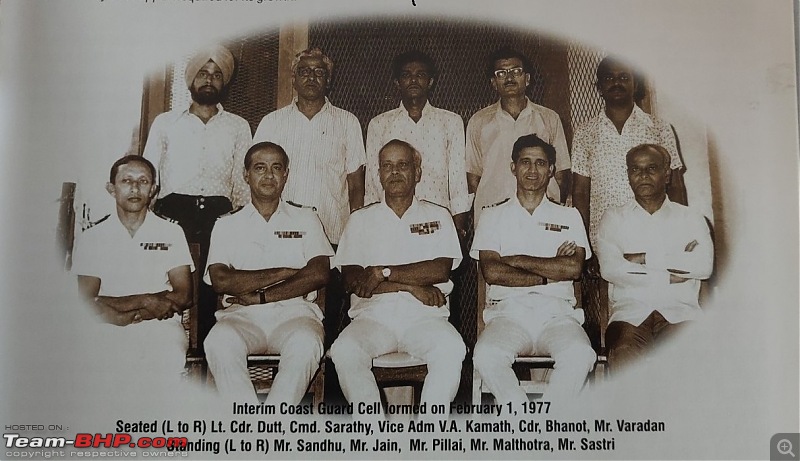 Source$$
Source$$
The nucleus team of 10 men who set up the Indian Coast Guard on 1st February 1977. They were led by Vice Admiral V.A. Kamath of the Indian Navy, seated in the centre. Kamath was the Vice Chief of the Navy and went on to set up the Coast Guard. This is a truly historic photo pinpointing the time and the team that created an Armed Force.
 Source $$
Source $$
The Coast Guard had modest beginnings with two small naval frigates INS Khuthar and INS Kirpan and five small coastal patrol boats were transferred from the Indian Navy along with officers and sailors to form the nucleus of this new force. This motley collection was an interim measure while new build ships came into service and the initial teams got trained.
Exclusive Economic Zone
 Source: Slideshare.net
Source: Slideshare.net
The EEZ extends to ~370 kms from the coast. Our EEZ measures 2.01 million sq kms or about 60% of our landmass. The coast line is a little over 7500 kms in length including 599 islands. With our maritime neighbours we have an overlap of EEZs and have through negotiations demarcated the sea border as the half way point. That is why you see the straight lines.
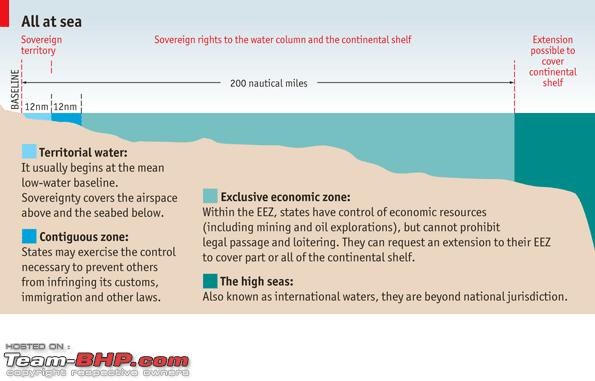 Source: Economist
Source: Economist
As the diagramme depicts a country's territorial waters extend to 12 nm {~22 kms}. A further 22 kms don't belong to its territory but it can enforce its laws or be in hot pursuit of an offender. And a total of 370 kms from the coastline is your EEZ.
The Coast Guard's Many Roles
The role of the Indian Coast Guard combines a sensitive mix of being part police, part customs enforcement, part protection of economic assets, part military, part ecological warrior and part rescue and relief. The need to constantly interface with the Police, Customs, Civil Administration make it different from the Indian Navy which is more focused on defence in depth, military power projection and offense where needed. The multiplicity and sheer complexity of roles a large Coast Guard like ours has to perform is not fully understood by the average bureaucrat or citizen.
The roles are wide ranging - protecting off shore oil wells, enforcing our fishery rights, monitoring maritime pollution and cleaning up oil spills, search & rescue, protecting marine life and supporting scientific expeditions, anti-smuggling operations, anti-piracy operations and maintaining a visible presence at sea over our EEZ.

 Source: mangaloretoday.com
Source: mangaloretoday.com  Source:martime-executive.com
Source:martime-executive.com
Fire fighting at sea. Given the constant and powerful movements of the sea one big risk is the fire fighter ship colliding with the ship on fire! Significant navigation skills are needed by the ICG vessel to stay close enough and yet far enough from the ship on fire.

 Source:news18.com
Source:news18.com
Rescue at sea. This was a case of the Indian CG rescuing Pakistani naval personnel when their patrol boat sunk at sea and the Pakistani Navy radioed for assistance. 2 were rescued and 4 others drowned before the ICG could locate them. At sea every one helps the other.
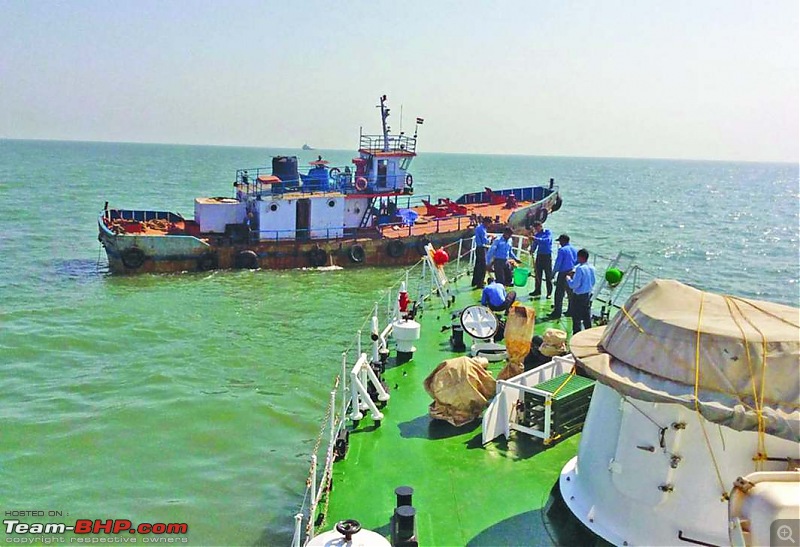 Source $$
Source $$
Search & Arrest operations against smugglers and drug runners. Around two or sometimes three major seizures occur
each month within India's territorial waters {12 nautical miles ~22kms}. Contraband seized runs up to well over Rs 1500 crores over the years. The boat being arrested here was found carrying narcotics from Myanmar.
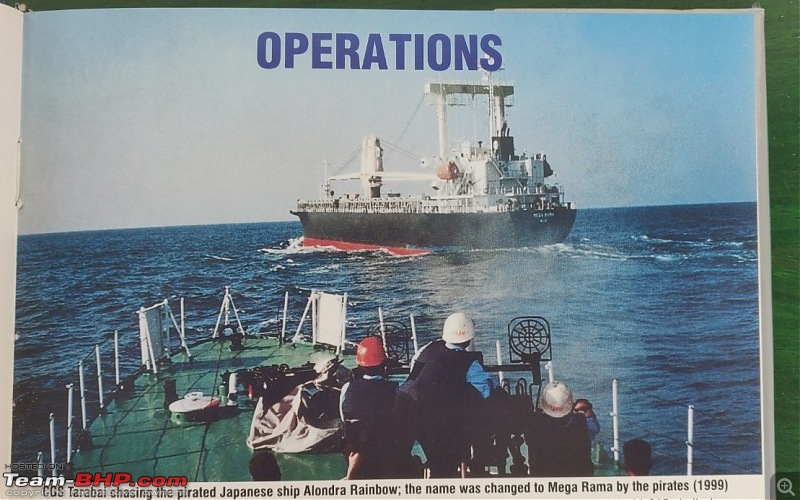 Source $$
Source $$
Anti-piracy operations. This was the first successful armed piracy operation in Indian waters thwarted in 100 years. India's Eastern waters are still amongst the most vulnerable to pirates.
 Source $$
Source $$
Protecting deep sea oil rigs at sea. India is now one of the largest users of off-shore oil rigs. At any point in time 40 to 50 could be in operation within the waters of the Indian EEZ. Each of these, especially those in waters closer to Pakistan, has to be protected from terrorist trouble.
 Source $$
Source $$
Pollution control chemical spraying to coagulate oil spills which are then sucked into bunkers on board CG ships. If you sail at sea you'll be surprised how often you come across small pools of oil floating on the sea - each a pollution hazard.
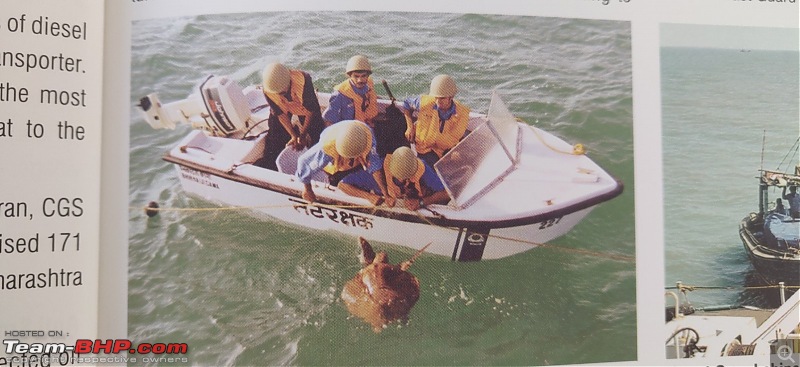 Source $$
Source $$
Protecting exotic marine life - Olive Riddley Turtles' nesting sites on the East Coast. the Coast Guard works directly with local Govt. authorities to preserve and protect endangered marine life
The Ships of the Coast Guard
In this section I have included only one or two examples of each of the 4 categories of ships in the ICG and not covered each of the 21 classes of ships that proudly fly the ensign of the Indian Coast Guard. An ensign is the flag of the Indian Coast Guard.
 Source: Wikipedia
Source: Wikipedia
Ensign of the Indian Coast Guard
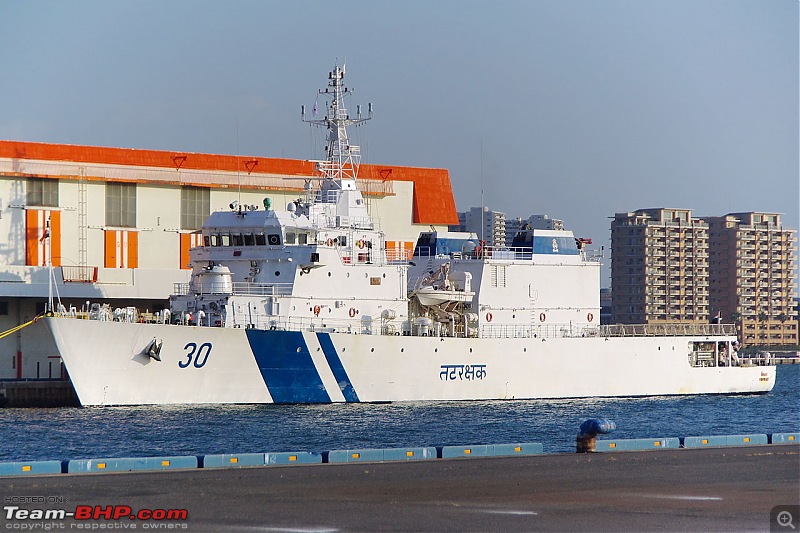 Source: Wikipedia
Source: Wikipedia
Racing Stripes painted on the hull of all ICG vessels and fuselage of all aircraft & helicopters
Pollution Sweeper 
 Source:maritime-executive.com
Source:maritime-executive.com
The ICG has three of this versatile class of ships. Designed by Rolls Royce and constructed by ABG Ship Builders it has a dynamic positioning system that enables it to stay at the same position despite the movements of the sea. This feature is much needed to stay next to the oil spill while sponging it up.
OPV
Offshore Patrol Vessels are the largest of the three basic types of vessels operated by the ICG. As goes the name these vessels sail out to patrol the maritime border of the EEZ and deter unwanted intruders - foreign trawlers, foreign sea bed mining ships, drug smuggling boats etc. They also provide long range deep sea capability for fire fighting, rescue, pollution control and increasingly these days anti-piracy operations. In order to operate in blue waters in all weathers these are typically in the 1800 to 2500 tonne bracket. India has been design its own OPVs from the very start in the early 1980s and making incremental improvements in each class. For our waters we find vessels in the 2200 to 2400 tonne range best suited.
India has 19 OPVs in service and another 2 under construction.

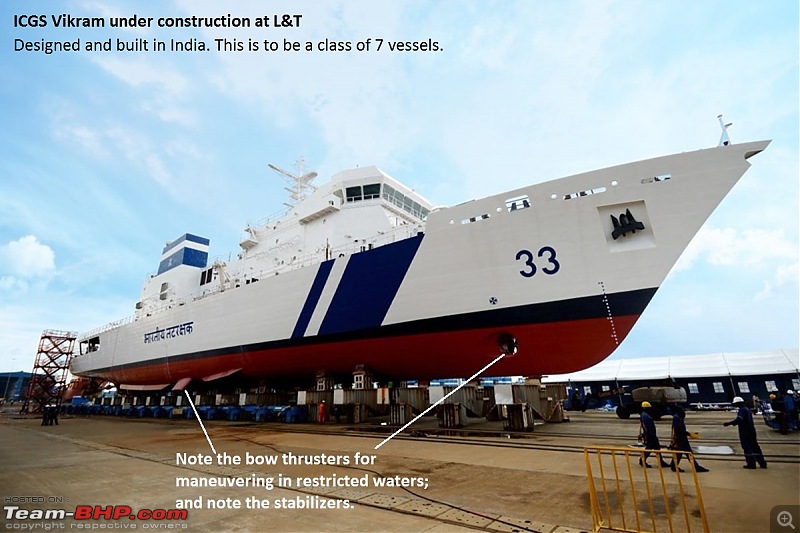 Source: lntshipbuilding.com Patrol Boats
Source: lntshipbuilding.com Patrol Boats
These are much smaller than an OPV and are typically deployed for coastal patrol and policing. They also serve as 'maids of all work' especially in the first 100 nautical miles (185 kms) from shore. Featuring a shallow draft they are able to sail close to the coast and up estuaries which the larger ships cannot always do. All 43 Large Patrol Boats currently in service across 7 classes have been designed and built in India. The ICG sensibly took in foreign design support from Australia, Japan and South Korea and kept stitching in incremental improvements from the first 200-tonne 'Rajhans' class to the latest 300-tonne 'Aadesh' class.
 Source:worldmaritimenews.com Interceptors/ Coastal Boats/Inshore Patrol Boats
Source:worldmaritimenews.com Interceptors/ Coastal Boats/Inshore Patrol Boats
These are the third type of basic vessel that make up the ICG fleet - Interceptor Boats for short range rapid reaction. Also called Inshore Patrol Boats by the ICG. We have 68 in service. Their typical performance is a top speed of 45 knots and a patrol endurance of 24 to 48 hours. 45 knots for a boat is like 400 kmph for a car! The only way such speeds can be achieved in water is by lifting the forward hull up out of the water thus cutting down drag. Though small their navigation & surveillance suites are similar to larger ships and appropriate for night operations in closed waters. the water jets that power them help reduce the draft and thus confer the ability to sail into shallow waters.
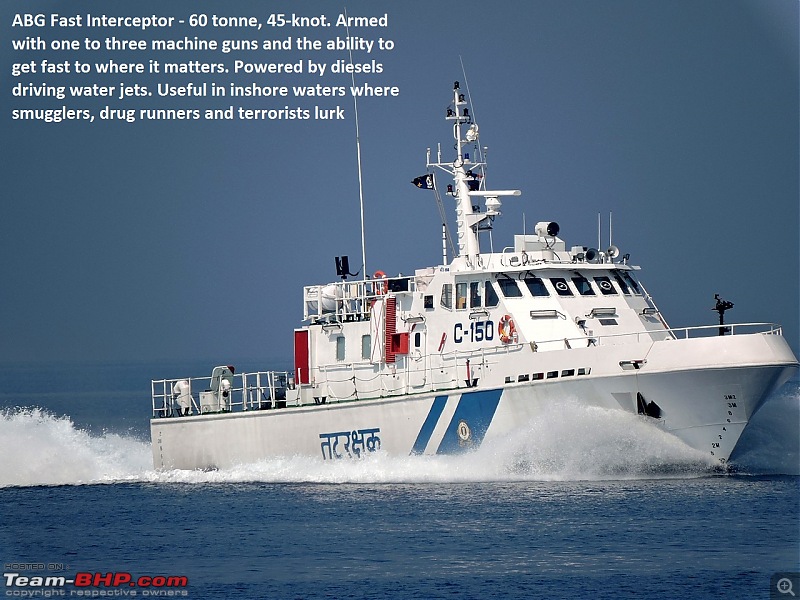 Source: lntshipbuilding.com
Source: lntshipbuilding.com  Source: Wikipedia Hovercraft
Source: Wikipedia Hovercraft
Hovercraft are ideal vessels to take you through surfaces that are too thin to drive over and too thick to sail through. They are ideal for operating in the interface points of sea and land and do not need a port or harbour with depth. For close shore waters, inland waters, estuarine waters hovercraft are the right amphibians. The ICG operates 18 Griffon TD8000 medium sized hovercraft that have served the Force well for almost 2 decades.
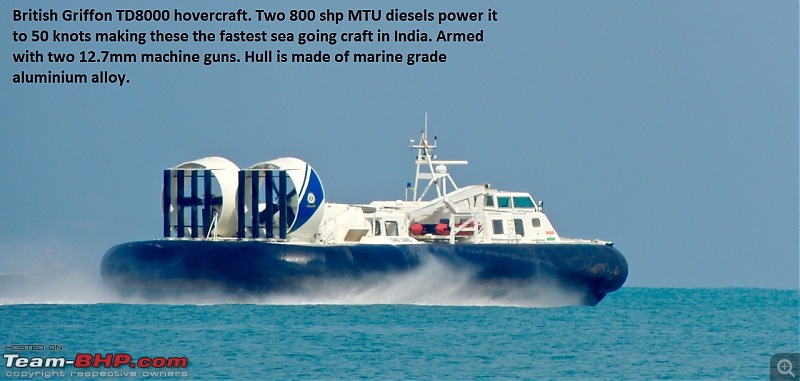
 Source Deccan Herald CRN-91
Source Deccan Herald CRN-91  Source:Wikipedia
Source:Wikipedia
No essay on the ICG can be complete without touching upon its principal weapon the CRN-91 30mm automatic cannon. Designed by DRDO and derived from the highly successful Russian 30mm army cannon this weapon can fire up to 550 rounds per minute out to an effective range of 4000 metres. It is directed by an optronic fire control system for day and night use. It is a simple easily maintained weapon effective for policing duties.
RHIB  Source: Wikipedia
Source: Wikipedia
Rigid Hull Inflated Buoyancy boat - a most useful piece of equipment that allows the main CG ship to extend its strong arms around both trouble makers and folks in trouble at sea. These are boats, as the photo shows that are made typically of GRP, Aluminium or a mix of wood and carbon fibre with a large inflated balloon all around the top side hull edge. Net net this design prevents the boat from sinking or capsizing permanently as the inflated balloon acts as a life jacket. Typically fitted with powerful motors and one or more machine guns it becomes an extension of the ship. Most OPVs would typically carry two 9-metre RHIBs. Large patrol boats would carry one 5-metre RHIB.
Aircraft of the Coast Guard
Patrol from the air augments and compliments patrol by ship. While an aircraft cannot arrest, search a ship, seize contrabands it can survey vast areas of ocean in a relatively short period of time to find out where potential for trouble or need for help lies. The mere presence of an air patrol is often a deterrent for trouble makers. It is a cost effective method, in both time and money, to sniff out and then direct the ships to the point of action.
Fixed wing and rotary wing aircraft are used by the ICG for patrol & policing, armed deterrence, rescue, transporting relief materials & cleaning up oil spills.
Dornier Do228  Source: JetPhotos
Source: JetPhotos
Dornier Do 228 the reliable work horse of the ICG. 23 of these hard working patrol aircraft are operated by the ICG. They are fitted with a maritime surface surveillance radar and devices to detect oil pools (which by the way are very common today) floating on the sea. They can be equipped with oil pollution controlling chemical sprays, 7.62mm light machine gun pods and dinghies for dropping at sea.
HAL Dhruv  Source Wikipedia
Source Wikipedia
The HAL Dhruv is an indigenous design. Twin engine with a useful payload of 1500kgs/14 passengers or 11 fully equipped troops. Lavishly fitted with modern avionics for search, identification and tracking. 16 more are on order.
HAL Chetak  Source: JetPhotos
Source: JetPhotos
India's most loved choppers, the sisters - Chetak and Cheetah. Produced by HAL since 1969. 17 on strength.
Over the period 1978 to 2015 the Indian Coast Guard among many other contributions had clocked in the following:-
Lives saved : 6827
Medical Evacuations : 212
Major Disaster Relief Operations : 32
Anti-Narcotics & Smuggling, number of vessels arrested & seized : 798
Vessels apprehended for harming or smuggling marine wild life : 259
Since then these figures have been exceeded handsomely.
Jai Hind.
Sources:
Indian Coast Guard, 25 Glorious Years. Published by the Indian Coast Guard HQ, New Delhi $$
CG Information brochure 2015
Excellent thread, a treasure trove of information on the ICG. By the way, is the coast guard officered from the Navy or do we have direct recruits as officers and IPS or other central cadre for the senior positions?
Excellent reading material. Knowledgeable too. So proud to know that much of the equipment used by the CG is indigenously made. Makes me proud of DRDO as well. In news, we only get to hear that we import all our security requirements. I hope we export all these vessels too. It will make for a very interesting read about our exports of this equipment to various countries. Maybe you can compile that too.
Also, until now, I used to think CG is Indian navy only.
And the racing stripes!! Marvellous. Whoever got the idea.
Excellent article as always sir.
I personally feel the ICG should upgun their 30mm main gun to the 76mm Oto Melara SRGM, especially for their OPV’s. They can then engage at a greater range and pack more firepower for small flare ups.
On a side note it’s heartening to see the IN finally upgun their latest under construction destroyers to 127mm guns.
Thanks V.Narayan ji for putting in the time & effort for this very informative thread.
Always thought the Indian Coast Guards was a part of the Navy but was enlightening to know their role was much more (pollution control, exotic marine life preservation etc.) than to only keep the territorial waters of India safe.
:thumbs up
Excellent and very informative write up. I had no idea of the size of the Indian Coast Guard. Very impressive, some nice looking vessels too.
It is interesting to see how different nations organise their coast guard. Typically they are far removed from a true defence role and need to take on a much broader role. They need to “serve” multiple masters.
In the Netherlands the coast guard is representing six different ministeries. They all used to have their own “coastal responsibilities” (e.g. finance/customs, law and order, defence etc). And they had their own organisations. In the 1980s that was all rolled into one coastal Guard organisation with the relevant mandates and authorities. Operationally it comes under the Dutch navy. Although, I am pretty sure its crew are mostly merchant navy.
None of our coast guard vessels are armed.
Yet another wonderful thread by V Narayan. Thanks so much! Rated 5 Star.
It is wonderful to read about the CG and its vessels and air arm. The CG is always at work and flies under the radar without seeking or getting much attention.
In use and in design how do the different big guns (field, tank, naval) differ? Asking because Rommel used AA guns as field/ anti tank guns to devastating effect.
Regards
Sutripta
Thanks for compliment sir. I too read a lot about weapons, but I am too lazy to type things unlike you😁.
I was reading somewhere that the new 127 mm guns will be having a range of around 72 kms with base bleed rounds, called vulcano rounds. The Americans have also test high velocity shells, as an alternative to multi million dollar missiles and as a precursor to rail guns. The test ship was USS Dewey. I am also happy naval artillery is making a comeback. The US Navy has used its Mississippi Class battleship and other heavy ships to devastating effect in softening coastal defenses before invasions. They were a low cost and effective weapon, unlike the expensive missiles.
Coming back to the coast guard, I have read that they are to play second fiddle to the navy in war. The IN has the Sukanya Class as its offshore patrol vessel, and they have similar tonnage to the ICG OPV's, but they have the 76mm SRGM. Hence i was arguing the need for ICG to also have 76mm guns on a few ships for contingencies. And with increasing Chinese presence in the IOR and with terrorists getting more and more advanced weapons, our ships on the high seas need weapons which fire farther and faster than what the adverseries will throw at them.
Excellent Thread Sir. Rated a well deserved 5 stars. Have come across Coast Guard ships quite a few times when sailing in Indian waters. The CG ships with their White Hull and Blue Racing Stripes stand out from the Indian Navy ships which were generally Grey in colour.


 Source$$
Source$$ Source $$
Source $$ Source: Slideshare.net
Source: Slideshare.net Source: Economist
Source: Economist
 Source: mangaloretoday.com
Source: mangaloretoday.com Source:martime-executive.com
Source:martime-executive.com
 Source:news18.com
Source:news18.com Source $$
Source $$ Source $$
Source $$ Source $$
Source $$ Source $$
Source $$ Source $$
Source $$ Source: Wikipedia
Source: Wikipedia Source: Wikipedia
Source: Wikipedia
 Source:maritime-executive.com
Source:maritime-executive.com
 Source: lntshipbuilding.com
Source: lntshipbuilding.com Source:worldmaritimenews.com
Source:worldmaritimenews.com Source: lntshipbuilding.com
Source: lntshipbuilding.com Source: Wikipedia
Source: Wikipedia
 Source Deccan Herald
Source Deccan Herald Source:Wikipedia
Source:Wikipedia Source: Wikipedia
Source: Wikipedia Source: JetPhotos
Source: JetPhotos Source Wikipedia
Source Wikipedia Source: JetPhotos
Source: JetPhotos